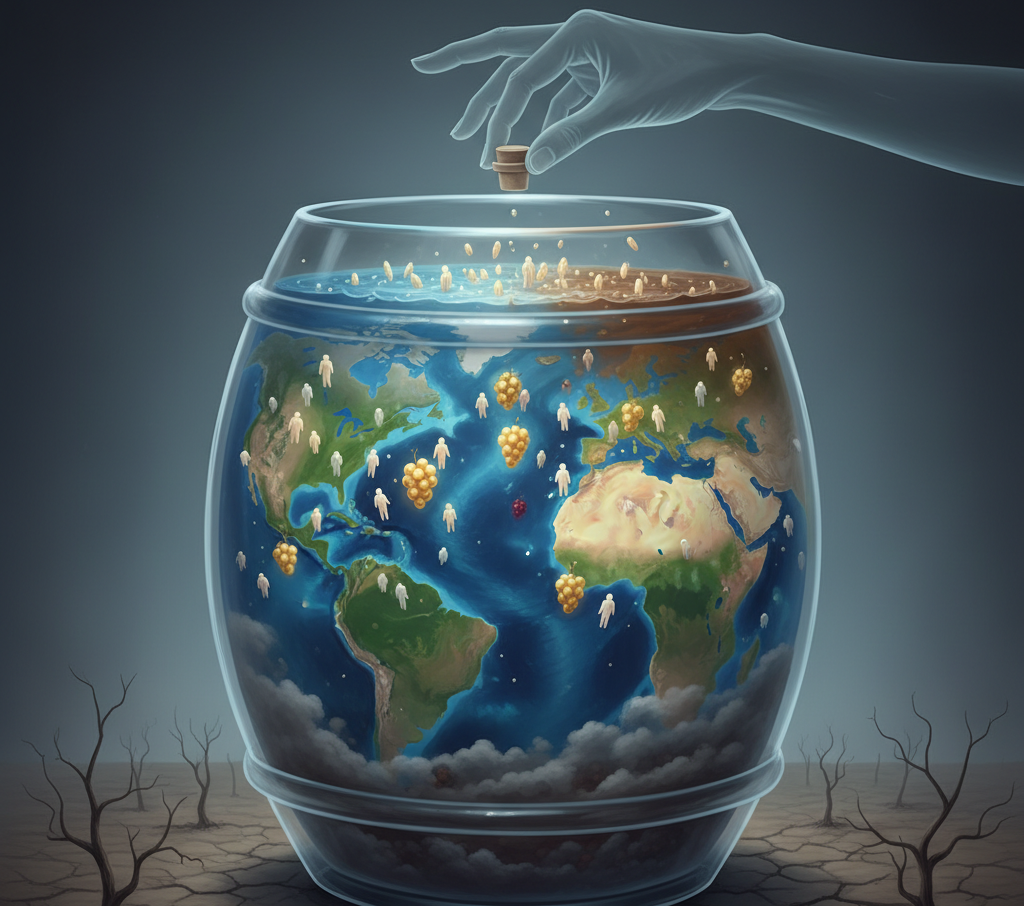Humanity is proud of its technological achievements, cultural milestones, and relentless quest for progress. But zoom out for a moment. Imagine Earth as a giant barrel, and humanity as the yeast fermenting inside. Are we destined to meet the same fate as yeast in a winemaker’s vat, drowning in our own byproducts? Could our trajectory lead to extinction? Let’s explore this provocative analogy and see what it might teach us about our future.

The Yeast Analogy
Yeast are simple, single-celled organisms that perform a remarkable feat: they convert sugar into alcohol and carbon dioxide, fueling the process that creates wine. Initially, their environment is a paradise — sugar-rich and abundant with nutrients. The yeast multiply rapidly, thriving in the bounty.
But there’s a catch. As they consume the sugar, they produce ethanol, which is toxic to them. Eventually, the rising alcohol concentration and dwindling nutrients lead to their demise. The yeast die off, leaving behind a transformed environment — wine for the winemaker but a dead-end for them.
Now, let’s swap yeast for humans and the barrel for Earth. Our sugars are fossil fuels, forests, minerals, and other natural resources. We, too, are converting these raw materials into byproducts: carbon emissions, pollution, and environmental degradation. Are we heading toward a similar collapse?
The Human Barrel
Humanity has been thriving for millennia, exploiting Earth’s resources at an ever-accelerating pace. Like yeast in a barrel, we’ve seen exponential growth — in population, technology, and consumption. But our actions are altering our environment:
- Climate Change: Our industrial activities release greenhouse gases, heating the planet and disrupting ecosystems. Rising temperatures could be the equivalent of alcohol toxicity for yeast.
- Resource Depletion: We’re consuming nonrenewable resources at unsustainable rates. Just as yeast runs out of sugar, we may face shortages of energy, water, and arable land.
- Pollution: Our byproducts — plastics, chemicals, and waste — are poisoning the very systems we depend on for survival.
Can Humans Escape the Barrel?
Yeast can’t escape their barrel. They lack the intelligence, tools, or mobility to change their circumstances. Humans, however, are different. We have foresight, creativity, and the ability to adapt. But will we use these abilities effectively? Let’s examine our options:
- Technological Innovation: Advances in renewable energy, carbon capture, and sustainable agriculture could mitigate our environmental impact. This is akin to introducing oxygen into the yeast’s barrel to give them a second wind.
- Expansion Beyond Earth: Space exploration and colonization are often touted as humanity’s ultimate escape hatch. Could Mars or other planets become new barrels for us to exploit? Or are we just kicking the can down the cosmic road?
- Behavioral Change: Unlike yeast, we can make conscious choices to consume less, waste less, and live within our planet’s means. But this requires global cooperation, a feat we’ve struggled to achieve.
- Extinction: The darkest possibility is that we, like yeast, will overwhelm our environment, succumb to our byproducts, and face extinction. If this happens, Earth may eventually recover and evolve new life, just as a barrel is emptied and reused.
How Probable Is Extinction?
The probability of human extinction is difficult to quantify, but it’s no longer a far-fetched idea. Climate scientists warn of tipping points — thresholds beyond which environmental damage becomes irreversible. Biodiversity loss, ecosystem collapse, and global conflicts over dwindling resources are all real threats.
However, humans have a unique advantage: self-awareness. We can observe our trajectory, recognize the dangers, and change course. Yeast lack this ability. But awareness alone isn’t enough. Action is what separates survival from extinction.
A Cautionary Tale
The yeast in a barrel teaches us a simple but profound lesson: unchecked growth in a finite system is a recipe for collapse. Humanity’s challenge is to learn from this microbial fate and avoid becoming the yeast of Earth’s barrel. Can we slow down, clean up our mess, and find a sustainable way to coexist with our environment? Or will we, too, meet our end, drowning in the byproducts of our success?
The answer lies in our ability to balance growth with sustainability, innovation with restraint, and ambition with humility. The barrel is big, but it’s not infinite. The choice is ours — and the clock is ticking.